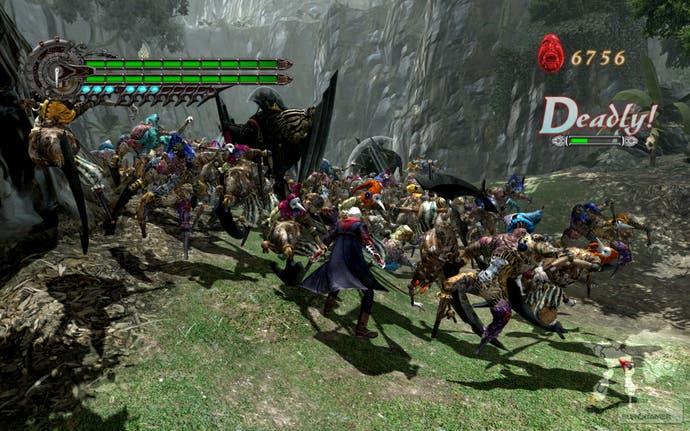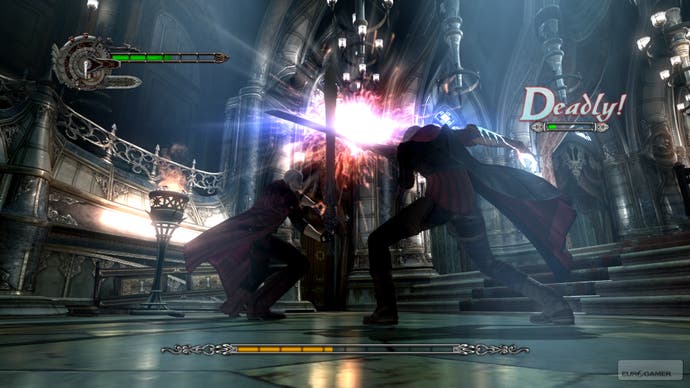Devil May Cry 4
But PC owners may shrug...
As a franchise, there doesn't seem to be much about Devil May Cry that would appeal to the stereotypical PC gamer. A series founded on relentlessly aggressive repetition, button-mashing combat and an overwhelming sense of style over substance, it should fit the expected (and, to be honest, hopelessly outdated) console gaming model far better than the supposedly more sophisticated PC crowd.
Such concerns wouldn't be so noticeable if Devil May Cry 4 had straddled the PC/console divide at launch, but when the PC version turns up six months later you have to wonder who, exactly, has been waiting for it to arrive on this format? And what does Capcom have to offer those patiently sitting in front of their monitors, joypad in hand, unable to play the game on the 360 or PS3?
New game modes, basically. Two of them, to be precise, but both seem geared towards hardcore fans who have already mastered the game and are looking for that little extra challenge. Fans, in other words, who would surely already have sought out the game in its console form...
But let's not keep getting hung up on such matters. What are these modes, and what the hot sticky fudge do they offer? Turbo Mode is the most obvious - it speeds the game up to ker-azy levels and, well, that's it. It's not the sort of thing that would take terribly long to implement - my impeccable coding knowledge tells me that you simply have to type > MAKE GAME FAST PLZ into a big monitor with flashing lights - and it's not the sort of thing that's going to appeal to anyone but the most masochistic player in the long term. It's fun to try it for a level or so, just to see what it's like, but it's not really fun and it doesn't improve the game in any tangible way.
Legendary Dark Knight mode is the other new feature, in which you control Batman and must chase the ghost of Heath Ledger around a virtual Gotham City. Or, to put it another (and vastly more accurate) way, it fills the screen with as many enemies as your graphics card can handle and forces you to carve your way through them like a demented lawnmower. It's nothing that hasn't been done already in KOEI's long-running Samurai Warriors, and its various spin-offs, but it's never been done with the polish and style of Devil May Cry, which certainly makes it worth a look. Again though, it's a secondary amusement rather than a substantial addition to the game.

Apart from those fun but minor diversions, the only other feature that's being touted as new to the PC is "custom graphics settings". This is a rather strange boast, given that every PC game offers custom graphics settings simply because of the nature of the platform. It's a bit like when a DVD lists "interactive menus" as a special feature. Still, there's no denying that Devil May Cry 4 was always designed for maximum visual impact, and the ability to whack that detail up to true HD resolution showcases the game's unique artistic sensibility to impressive effect. Some of the enemies have been shifted about as well, but you'd have to memorise the entire game to really notice this. Or look it up on the internet. Like I did.
Other than that, you're getting almost the exact same game as those grunting console owners got back in February. It's a handsomely mounted action game, no doubt, but as with too many Capcom franchises it suffers from an aging game engine buried under the shiny new coat of paint. The Devil Bringer ability mixes things up a little bit, allowing you to grapple from specified spots and also grab enemies from afar, but for 99 percent of the time it's a question of using gun and sword to juggle, maim and slaughter wave after wave of grisly demonic foes - just as we've been doing for seven years in the previous games. Bosses are large and rely on pattern-based attacks, while the coloured orbs that top up your various gauges and abilities have remained the same since fellow Capcom demon-slasher, Onimusha. New lead character Nero even has the old "demon hand" thing going on. All too often, the game feels like Capcom's Greatest Hits rather than a new and invigorating title in its own right.
Cut-scenes are a painful mixture of western emo-goth cliché and eastern anime melodrama, while the voice acting is as...enthusiastic as ever. Not that the script gives the actors much to work with - the dialogue wouldn't make the grade in a 1980s action movie. For many this is part of the charm of Capcom's action and horror games, but there comes a point where unrehearsed cheesiness becomes embarrassingly self-conscious, and the poundingly repetitive nu-metal combat music certainly won't make you feel any more receptive to the game's florid infernal soap opera storyline.

When you're not fighting, you're trotting through gorgeously rendered yet strangely lifeless environments, smashing the obligatory boxes and pots to earn yet more glowing orbs. It looks lovely, but is also painfully flat and old-fashioned. This is a game world with no depth and no physics other than that pre-rendered into the cut-scenes. The fixed camera angles, that even Resident Evil has since abandoned, ensure that you always get the most impressive view of the grand gothic scenery, but as much fun as it is to pile into a gang of monsters there's always a nagging disconnect behind the glittering distraction. It feels like a game in search of its own identity, anything of substance to justify our anticipation for the inevitable Devil May Cry 5.
Good looks and dumb fun will only get you so far. Capcom has always clung to archaic game engines way past their sell-by date, and cranked the sequel handle a little too quickly, reusing tired elements until the cries of derision become too loud. This bout of monster mashing is still fun, yes, but Devil May Cry has now reached the point where it desperately needs to evolve into the 21st century as with Resident Evil 4, or fade from the spotlight like Dino Crisis.


